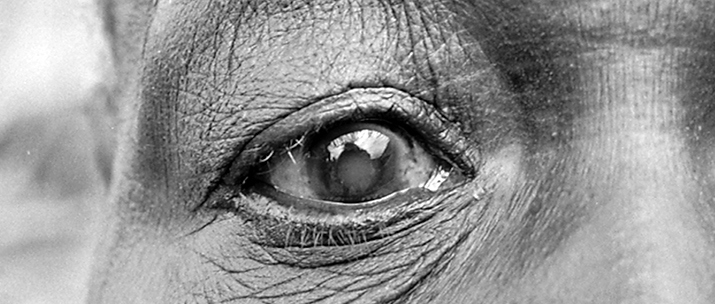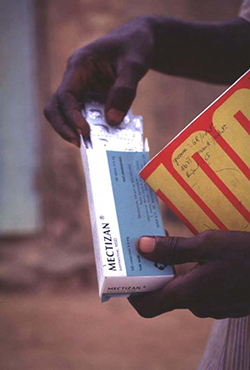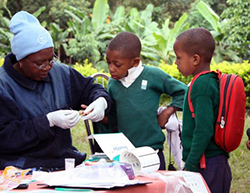Combating parasitic diseases
After nearly a decade of digging in the dirt, researchers in the 1970s unearthed a novel treatment for parasitic infections. The scientists had sifted through hundreds of thousands of soil samples before coming up with the powerful properties of ivermectin. Ivermectin is potent, cheap to produce and easy to administer. After its success as a veterinary antiparasitic, ivermectin won approval in 1987 for use in humans, bringing hope to the hundreds of millions of people suffering from debilitating, yet neglected, tropical diseases.

 ≈å≤—±´∏È¥°
≈å≤—±´∏È¥°
On Dec. 10, 2015, , a member of the Õµ≈ƒÕµø˙ and Õµ≈ƒÕµø˙ Biology, will receive part of the Nobel Prize in medicine for his work on ivermectin, which is used to treat river blindness and lymphatic filariasis. will split one half of the prize with of Drew University, who worked on ivermectin as a member of Merck’s natural products team. (≈å≥æ≥Ð∞˘≤π and Campbell will receive the Nobel Prize alongside Tu Youyou, who is recognized for her discovery of artemisinin, an antimalarial drug.)
Origins of disease
River blindness and lymphatic filariasis both are caused by parasitic roundworms and are endemic to some of the world’s poorest areas. Rural regions of sub-Saharan Africa are affected most severely by river blindness, although the disease also is found in limited areas in South and Central America and Yemen. Lymphatic filariasis, often referred to as elephantiasis, occurs in tropical and subtropical regions of Asia, Africa, South America, the Western Pacific and the Caribbean.
River blindness is spread among humans by blackflies. The flies become infected with microscopic larvae by feeding on the blood of an affected person and then pass the worms from host to host. Lymphatic filariasis is spread in a similar fashion by certain species of mosquitoes. For both diseases, a person must be bitten many times to become infected, so short-term visitors to these regions typically are unaffected.
In river blindness (also known as onchocerciasis), as the worms mature, they cause nodules in the skin that itch unbearably. Often they permeate the cornea, leading to a loss of vision. Patients with advanced river blindness often are unable to work and may exhibit irrational behavior. Their skin begins to look aged. Lesions caused by scratching leave the skin vulnerable to bacterial infection.
The flies that transmit river blindness live near rivers and streams; fertile farmland sometimes is abandoned as a result. In addition to being economically crippled by a loss of able-bodied workers, villages afflicted with river blindness often are shunned by neighboring communities for being unclean.
In lymphatic filariasis, worms infiltrate and damage the lymphatic system, sometimes with no external symptoms. Rarely, a victim will develop lymphedema, a swelling in the limbs, breasts or genitals. Damage to the lymphatic system leaves the patient with a decreased ability to fight off infection, and the swelling associated with lymphedema can be physically impeding.
According to the World Health Organization, more than 25 million people have river blindness worldwide. The Centers for Disease Control and Prevention estimates that lymphatic filariasis affects more than 120 million people.
Origins of ivermectin
In the 1970s, there was a great interest in medicines derived from natural products. Conducting research at the Kitasato Institute in Japan, ≈å≥æ≥Ð∞˘≤π collected thousands of soil samples from all over the country in hopes of discovering microbes with medicinal applications. He isolated strains of Streptomyces bacteria from the samples and cultured them in his laboratory.
In 1974, he found a particular strain of Streptomyces bacteria in a soil sample that he had collected from a nearby golf course. He sent it, along with 49 other of the most promising soil samples, for testing at the U.S. pharmaceutical company Merck. Working as a visiting professor at Wesleyan University a few years prior, ≈å≥æ≥Ð∞˘≤π had made connections with the American pharmaceutical industry; upon his return to Japan, he established a partnership with Merck with the aim of developing new veterinary drugs.
Rather than hunting for a cure to a particular disease, researchers in Merck’s natural product isolation unit were tasked with identifying any compounds that might have activity against pathogenic microorganisms. At the company’s New Jersey location, the scientists sifted through samples from ≈å≥æ≥Ð∞˘≤π and others over the course of a decade.
The researchers fermented the soil sample containing the Streptomyces and found that the bacteria were producing avermectins. Avermectins are thought to be part of the bacteria’s natural self-defense system. Bacteria likely produce avermectins to paralyze the soil worms who feed on them.
While at Merck, Campbell and his colleagues demonstrated that avermectins were particularly effective against parasitic worms. Researchers isolated and purified 16 avermectin derivatives. They selected the most potent one and chemically modified it to make it less toxic. The result was ivermectin.
Ivermectin originally was used as a veterinary antiparasitic therapy. It rapidly became the market leader in antiparasitic veterinary treatment and has generated an average of $1 billion in annual sales. Ivermectin is perhaps most recognizable in the U.S. as the active ingredient in the heartworm preventative Heartgard. It also combats mites, ticks and insects.
In 1981, clinical trials of ivermectin in humans began in Senegal. Before ivermectin, the only available treatments for river blindness either caused severe side effects or were impossible to administer to patients on a large scale.
 Ivermectin is distributed throughout affected regions under the brand name Mectizan. PHOTO COURTESY OF THE WORLD HEALTH ORGANIZATION
Ivermectin is distributed throughout affected regions under the brand name Mectizan. PHOTO COURTESY OF THE WORLD HEALTH ORGANIZATION
How ivermectin works
Ivermectin is extremely effective at paralyzing parasitic worms.
Ching Chung “C.C.” Wang worked at Merck in the 1970s and discovered the mechanism of action for ivermectin. (Every year, the ASBMB issues the , which was established by Wang and his wife.)
Ivermectin works “by opening the GABA receptor-controlled chloride ion channel,” says Wang. “It keeps the chloride ion channel open, so there is no response signal from the central nerve to the motor neuron.”
With no neurotransmission between the central nervous system and the motor neurons, larval nematodes are paralyzed, making them unable to reproduce. Once the adult parasites have died off, the population within the human host declines.
Ivermectin is unique in that it does not cross the blood-brain barrier, so it does not have the same harmful effect on humans as it does on parasites.
Treatment once a year is enough to control the river blindness parasite, but a patient must receive ivermectin every six months for several years to be cured. When administered annually, a combination of ivermectin and albendazole, another antiparasitic that is made by GlaxosmithKline, can prevent the spread of lymphatic filariasis.
Public—private partnership
 A technician in Tanzania tests school-age children for lymphatic filariasis. PHOTO COURTESY OF THE CENTERS FOR DISEASE CONTROL AND PREVENTION.
A technician in Tanzania tests school-age children for lymphatic filariasis. PHOTO COURTESY OF THE CENTERS FOR DISEASE CONTROL AND PREVENTION.
Executives at Merck in the 1980s were faced with a quandary: Their scientists had unearthed one of the most powerful human antiparasitic treatments ever discovered. It had the potential to cure hundreds of millions of people suffering from neglected tropical diseases. However, they were unable to market the drug in the affected areas without being accused of exploitation. What happened next was a humanitarian triumph that has served as a model for drug distribution in the developing world.
In 1987, P. Roy Vagelos, then the chief executive officer of Merck, decided to give the drug away for free for as long as necessary to eradicate river blindness. Merck partnered with the World Health Organization, the World Bank and several nongovernmental organizations to distribute the drug to nations where the disease was rampant.
“If you think about public-private partnerships, this is the model, particularly for neglected tropical diseases, where there isn’t a lot of market-driven incentive to make these types of drugs,” says , a parasitologist at Virginia Polytechnic Institute and State University. The partnership has served as a model for drug donations by other pharmaceutical companies, such as albendazole by GlaxoSmithKline, which is used in combination with ivermectin to treat lymphatic filariasis.
The Nobel announcement noted that ivermectin has “radically lowered the incidence of river blindness and lymphatic filariasis.” ≈å≥æ≥Ð∞˘≤π and Campbell’s discovery has “provided humankind with a powerful new means to combat these debilitating diseases that affect hundreds of millions of people annually,” it said.
Using ivermectin coupled with an insecticide program, the United Nations’ Onchocerciasis Control Programme cured 30 million people of river blindness in West Africa between 1974 and 2002. The , a nongovernmental organization working to fight river blindness, is campaigning to increase treatment to two times a year in parts of the world that remain affected. It hopes to eliminate the disease worldwide by 2025.
Enjoy reading ASBMB Today?
Become a member to receive the print edition four times a year and the digital edition weekly.
Learn moreGet the latest from ASBMB Today
Enter your email address, and we’ll send you a weekly email with recent articles, interviews and more.
Latest in Science
Science highlights or most popular articles

Transforming learning through innovation and collaboration
Neena Grover will receive the William C. Rose Award for Exemplary Contributions to Education at the 2025 ASBMB Annual Meeting, April 12–15 in Chicago.

Guiding grocery carts to shape healthy habits
Robert “Nate” Helsley will receive the Walter A. Shaw Young Investigator in Lipid Research Award at the 2025 ASBMB Annual Meeting, April 12–15 in Chicago.

Quantifying how proteins in microbe and host interact
‚ÄúTo develop better vaccines, we need new methods and a better understanding of the antibody responses that develop in immune individuals,‚Äù author Johan Malmström said.

Leading the charge for gender equity
Nicole Woitowich will receive the ASBMB Emerging Leadership Award at the 2025 ASBMB Annual meeting, April 12–15 in Chicago.

CRISPR gene editing: Moving closer to home
With the first medical therapy approved, there’s a lot going on in the genome editing field, including the discovery of CRISPR-like DNA-snippers called Fanzors in an odd menagerie of eukaryotic critters.

Finding a missing piece for neurodegenerative disease research
Ursula Jakob and a team at the University of Michigan have found that the molecule polyphosphate could be what scientists call the “mystery density” inside fibrils associated with Alzheimer’s, Parkinson’s and related conditions.

